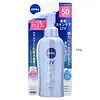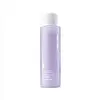What's inside
What's inside
 Key Ingredients
Key Ingredients

 Benefits
Benefits

 Concerns
Concerns

 Ingredients Side-by-side
Ingredients Side-by-side

Water
Skin ConditioningEthylhexyl Methoxycinnamate
UV AbsorberAlcohol Denat.
AntimicrobialPropylene Glycol
HumectantDimethicone
EmollientEthylhexyl Triazone
UV AbsorberDiethylamino Hydroxybenzoyl Hexyl Benzoate
UV FilterButylene Glycol
HumectantLysine Lauroyl Glutamate
CleansingPyrus Cydonia Seed Extract
MaskingGeranium Robertianum Extract
AstringentPhellodendron Amurense Bark Extract
Skin ConditioningSodium Hyaluronate
HumectantAcrylates/C10-30 Alkyl Acrylate Crosspolymer
Emulsion StabilisingCarbomer
Emulsion StabilisingTocopheryl Acetate
AntioxidantSodium Hydroxide
BufferingBHT
AntioxidantMethylparaben
PreservativeWater, Ethylhexyl Methoxycinnamate, Alcohol Denat., Propylene Glycol, Dimethicone, Ethylhexyl Triazone, Diethylamino Hydroxybenzoyl Hexyl Benzoate, Butylene Glycol, Lysine Lauroyl Glutamate, Pyrus Cydonia Seed Extract, Geranium Robertianum Extract, Phellodendron Amurense Bark Extract, Sodium Hyaluronate, Acrylates/C10-30 Alkyl Acrylate Crosspolymer, Carbomer, Tocopheryl Acetate, Sodium Hydroxide, BHT, Methylparaben
Water
Skin ConditioningGlycerin
HumectantPropanediol
SolventDipropylene Glycol
Humectant1,2-Hexanediol
Skin ConditioningGlycereth-26
HumectantButylene Glycol
HumectantBetaine
HumectantEthylhexyl Palmitate
EmollientGlycereth-25 PCA Isostearate
EmulsifyingCarbomer
Emulsion StabilisingCetyl Ethylhexanoate
EmollientTromethamine
BufferingArtemisia Princeps Leaf Extract
Skin ConditioningEthylhexylglycerin
Skin ConditioningPolyglyceryl-10 Oleate
Skin ConditioningDisodium EDTA
Biosaccharide Gum-1
HumectantSodium Hyaluronate
HumectantHydrolyzed Hyaluronic Acid
HumectantHyaluronic Acid
HumectantHydrogenated Lecithin
EmulsifyingCitrus Aurantium Bergamia Fruit Oil
MaskingPelargonium Graveolens Flower Oil
MaskingButyl Avocadate
Skin ConditioningGossypium Herbaceum Extract
Skin ConditioningSalvia Officinalis Oil
MaskingPogostemon Cablin Leaf Oil
MaskingSodium Lauroyl Lactylate
EmulsifyingCerium Oxide
Ceramide NP
Skin ConditioningPhytosphingosine
Skin ConditioningCeramide AP
Skin ConditioningCholesterol
EmollientPentylene Glycol
Skin ConditioningXanthan Gum
EmulsifyingCaprylyl Glycol
EmollientPlatinum Powder
AbrasiveCeramide EOP
Skin ConditioningWater, Glycerin, Propanediol, Dipropylene Glycol, 1,2-Hexanediol, Glycereth-26, Butylene Glycol, Betaine, Ethylhexyl Palmitate, Glycereth-25 PCA Isostearate, Carbomer, Cetyl Ethylhexanoate, Tromethamine, Artemisia Princeps Leaf Extract, Ethylhexylglycerin, Polyglyceryl-10 Oleate, Disodium EDTA, Biosaccharide Gum-1, Sodium Hyaluronate, Hydrolyzed Hyaluronic Acid, Hyaluronic Acid, Hydrogenated Lecithin, Citrus Aurantium Bergamia Fruit Oil, Pelargonium Graveolens Flower Oil, Butyl Avocadate, Gossypium Herbaceum Extract, Salvia Officinalis Oil, Pogostemon Cablin Leaf Oil, Sodium Lauroyl Lactylate, Cerium Oxide, Ceramide NP, Phytosphingosine, Ceramide AP, Cholesterol, Pentylene Glycol, Xanthan Gum, Caprylyl Glycol, Platinum Powder, Ceramide EOP
 Reviews
Reviews

Ingredients Explained
These ingredients are found in both products.
Ingredients higher up in an ingredient list are typically present in a larger amount.
Butylene Glycol (or BG) is used within cosmetic products for a few different reasons:
Overall, Butylene Glycol is a safe and well-rounded ingredient that works well with other ingredients.
Though this ingredient works well with most skin types, some people with sensitive skin may experience a reaction such as allergic rashes, closed comedones, or itchiness.
Learn more about Butylene GlycolCarbomer is a polymer of acrylic acid. Its main role is to create a gel consistency.
A high amount of carbomer can cause pilling or balling up of products. Don't worry, most products contain 1% or less of carbomer.
Sodium Hyaluronate is hyaluronic acid's salt form. It is commonly derived from the sodium salt of hyaluronic acid.
Like hyaluronic acid, it is great at holding water and acts as a humectant. This makes it a great skin hydrating ingredient.
Sodium Hyaluronate is naturally occurring in our bodies and is mostly found in eye fluid and joints.
These are some other common types of Hyaluronic Acid:
Learn more about Sodium HyaluronateWater. It's the most common cosmetic ingredient of all. You'll usually see it at the top of ingredient lists, meaning that it makes up the largest part of the product.
So why is it so popular? Water most often acts as a solvent - this means that it helps dissolve other ingredients into the formulation.
You'll also recognize water as that liquid we all need to stay alive. If you see this, drink a glass of water. Stay hydrated!
Learn more about Water